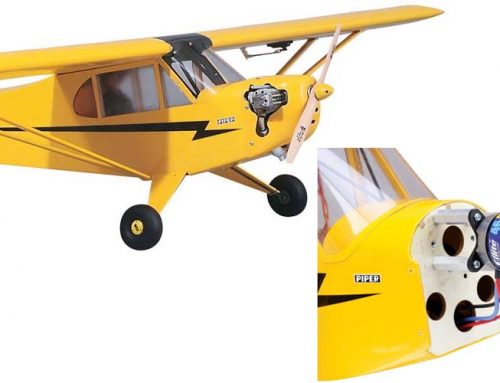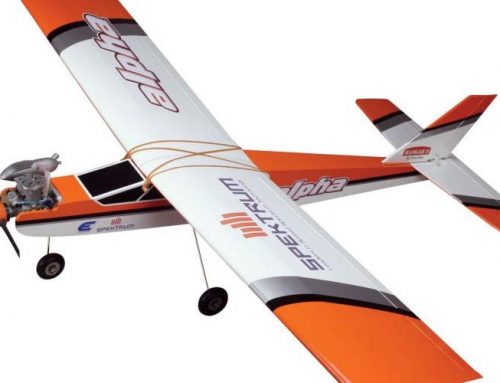First things first. If this is your first electric radio controlled plane, there are some key factors to take into consideration before your first flight.
Wind: You may be thinking that this is an obvious one. Why would I fly in wind? The question really is, how much wind is safe for an electric rc airplane? Remember, we are dealing with smaller aircraft that can only handle a Maximum of 5mph winds (That is THE MAX).
Orientation: This is so often overlooked by every beginner and takes some time to get used to. Your perception of up and down and left and right can easily be impaired when your plane is up in the air. Instead of practicing in the air, try this technique. Get a cheap rc car that has throttle and steering controls. Steer the car in the same pattern that you will fly in (a U shape is traditional). Remember, the steering will be reversed when the car is coming at you, this is where you need to become proficient.
Speed: It is imperative that you learn to control your speed. A common beginner mistake is to keep the throttle at full speed and forget to back down once the plane is in the air. Your plane will fly fine even with less than half throttle input from your transmitter. When landing, remember that you are going to be using even less power. Almost idling the motor will be enough to land.
Altitude: Most beginners believe that they need to keep their electric radio controlled plane low so that they can see it better. This is exactly what not to do. Most crashes happen because there is no room to make corrections. A good rule of thumb is to be at about 100 feet.
Over Control: Every beginner will do this, it just is part of learning how to “feel” the controls on the transmitter. Remember, you want to use slow movements to control your electric planes movements. It will take some getting used to, but you will get it, just be patient.
Pre-flight Check: What is this you may be wondering? It is an essential step. Follow it and you will always eliminate those forgetful steps (like forgetting to make sure your battery is charged fully). Make sure your plane is ready for the air on the ground, not in the air when it is too late.
If you are a beginner you will be looking at a LOT of choices for your first plane. In fact, because electric rc planes have become so popular, there are more choices than you can shake a stick at now.
Let’s narrow it down.
Start With A High Wing
Get an rc electric plane that has a high wing.
Forget about buying a flashy low wing sporty electric radio controlled plane. You will not be able to control it, and it will not be forgiving at all. Do yourself a favor and get a high wing electric for your first model.
Here are some of the most durable and most popular models for beginners…
Parkzone Night Vapor BNF Hands down this is one of the better beginner electric airplanes out there. If you start with this rc plane, you can teach yourself to fly. Best flown in wind under 5 MPH. Can be flown indoors as it is a slow flyer (essential for beginner rc plane pilots). No Assembly – Requires 4 Channel Transmitter – All Other Components Included (electric rc motor, ESC, servos, propeller, battery, etc).

Apprentice S 15e 1.5m with SAFE This plane is equipped with SAFE technology. SAFE is an on-board system that will correct the plane for you if something goes wrong (perfect for new rc pilots). Light Assembly (minutes) – All Components Included.

FMS Easy Trainer 1280 RTF Flies well and stands up to hard landings (a must for beginner flyers). Pusher prop means less propeller damage since it is behind the wing. Ailerons are included in the model (you can pin them to the wing until you are ready). Medium Assembly (under an hour) – All Components Included with RTF version.

Hobbyzone Sport Cub S RTF. This is a three channel plane that incorporates electronic anti-crash technology which actively monitors the plane’s orientation. (It corrects itself if you do something wrong, using the SAFE technology. Light Assembly (minutes) – All Components Included.

Choose An RTF (Ready To Fly)
For the least amount of headaches, start with an RTF or ARF (almost ready to fly)
The Apprentice S 15e with SAFE 1.5m RTF for instance, includes everything you will need to fly.
- Receiver – This device responds to the input from your transmitter. For example, if you push a control stick on your transmitter, the receiver picks up this signal, and relays the “command” to the servo that corresponds to the transmitter’s control stick movement.
- Electronic Speed Control (ESC) – It regulates the speed of the
electric rc motor by regulating the power to the motor to achieve the desired speed of your electric radio controlled plane (which is relayed from your transmitters throttle stick movements). The ESC also has two other functions- it has two circuits. The first is the LVC (low voltage cutoff) which will cut power to your electric motor and reserve the remaining power for the receiver and servos (so that you can still land your rc airplane). The other function of the ESC is the BEC (the battery elimination circuit supplies power to the receiver and the servos, thus eliminating the need for a separate battery.)
- Servos – Micro Size. These devices are what move the control surfaces of your rudder, elevator and ailerons (if included). They are connected to the receiver and “mimic” the movement of your transmitters control sticks.
- Battery – 3S 3200mAh 20C Li-Po battery. It is fine for starting out, but you will soon find that you need more power and run time.
- Charger – LiPo batteries are finicky things and require a load balancing charger. Most are included in kit to match battery.
- Propeller, control rods, linkage, landing gear and other components are included with most kits (but check to make sure).
TIP: Buy an extra battery, so when the first one is done you can keep flying.
Space To Fly Your RC Plane
Space…you need to consider how much space you will be flying in.
- Consider this… If you only have access to a local park, then you need to buy a rc plane that can be flown in that size space.
- Here is a quick break-down of what you can fly and not fly based on your safe flying area. (These figures are estimates and are appropriate for a beginner, but you should always fly in the biggest open area you can find, with no people nearby of course)…
- If your flying field (or park) is about the size of 1 football field, (200 x 200 feet) you will need to stick to small Park Flyers. These are lightweight planes that cannot be flown in any wind, and fly very slowly…just the thing for a beginner.
- If you have a bigger open space, say 600 x 600 feet (the size of 4 or 5 football fields), you can fly bigger and faster electric Park Flyers. These will typically be two pounds or less and fly slower than 40 mph. Usually they will use a Speed 400 or 480 electric brushed motors. You can fly with less throttle (1/2) and this will allow you more time to get used to the airplane.
Any bigger size flying area and you will be fine with whatever size plane you want to try. If you cannot find a place to fly, look up flying clubs in your area, or ask a farmer or rancher if you can fly in one of their pastures. There is always an option if you just look around.
Weight Of Your Plane
With electric radio controlled planes, weight will be a bigger factor.
Of course the technology is getting better and lighter batteries are being made that hold more charge and can allow you to fly for longer periods of time. However, when you really get into flying rc planes that are powered by an electric motor, weight will always be a greater factor to consider.
Price Of Electric Planes
You will spend about $200.00 for most everything you will need.
This will include the following. (Remember this is based on a RTF kit (that runs from $35 to $55.00), and is essentially the bare bones of what is needed to get into the air and fly.)
- Transmitter – This is the “box” that you hold and it controls your electric radio controlled plane in the air. Usually you will spend around $60.00 for a decent 4 channel radio. It is all based on your budget. You can easily spend $1000.00 dollars on a top of the line transmitter (most transmitters come with servos, this is standard). Stick with a basic radio to start out, but nothing under 4 channels, otherwise you limit yourself later on with planes that need at least 4 channels to control ailerons, rudder, elevator, flaps, retracts, etc…
- Crystal – A crystal is a small plug-in transistor that communicates on a certain frequency. Every transmitter has a crystal with a frequency (FM or AM or now GHz). You will need to check what the frequency of your crystal is and order one for the receiver in your electric plane. Cost is about $10.00.
- Battery Charger – Spend about $45.00 to get a charger that can charge by DC (your cars cell phone charger outlet). This way you can charge while you fly. Get one with peak detection (automatically knows when the battery is charged), the capability of charging NiCd and NiMH batteries, and the ability to charge up to 8 cells (at least).
Note: Make sure to get some charging leads for your charge so you can charge your specific battery packs. Cost is About $ 6.00.
Well, that is a lot of information and I hope it will help you make an informed decision towards buying your first electric plane. There is certainly a lot more information to each of the categories that I have gone over. But the goal of this article was to get you familiar with the essentials so that you could buy a RTF or ARF (I recommend a RTF to keep costs down) using this as a guide to fit your needs.
If you have any comments or need more help, I would be glad to answer any question you have.
Please post a question at our HTMRCA Blog for the quickest response to your questions. Or you can leave a comment about this article. You can also write just to say hi:). This is one big community and it’s great to get to know other electric radio controlled plane pilots.
Good Luck, and Happy Buying and Flying,
Carl Bayer
I have been flying and building radio controlled airplanes, helicopters, boats and cars for over 20 Years. I have been specifically building and flying electric airplanes for over 10 years. My latest interest is to convert balsa wood kits with gas engines, to models with electric motors. This has been more realistic to do lately because of the huge leap in battery technology and it has been a very fun way to still make balsa kit planes from scratch, but not worry about any gas problems.
If you would like to know more about how you can build Balsa Kits too, then check out my complete building system book on How To Build RC Airplanes



